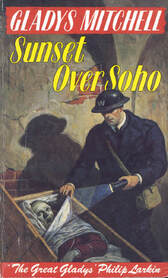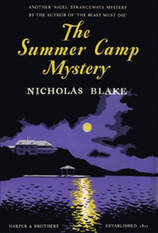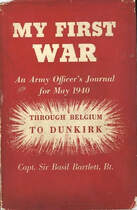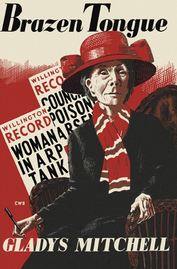REFLECTIONS

Tracy K. thought that Soho’s wartime setting – and the author’s attempt at verisimilitude – made this a memorable reading experience. She writes, “This is the best fiction book I have read about that war that includes so many elements of that time and its effects on people at home.” And Erin Cordell comments that the prose was “a very interesting style of writing… The last few chapters were almost like a long poem.”
As effective as the author’s presentation of a country at war might be, I must also agree with Joyka and Chris B. when they express disappointment with Mitchell’s characterization of her two leads. By the book’s conclusion, David Harben and his bewitching love interest Leda don’t have the weight or definition needed to make either of them a truly empathetic character. Certainly Mitchell comes closer to a resonant figure with Harben, as we spend more page time with him and, crucially, as he engages in a selfless act of courage in serving his country.
Joyka observes that “the sterling character we see in David during the Dunkirk rescue and as he is with the nuns and the orphan boys evaporates as he meets up once again with Leda. He returns to the morose, uncooperative schoolboy concerned only with his own love affair.” Joyka adds, “Perhaps his sterling character is envisioned only though the eyes of Mrs Bradley. I applaud Inspector Pirberry’s patience.”
Of all her Mrs Bradley books, Sunset over Soho is perhaps the one where tone and geographical/historical detail drive the novel’s reason for being, with the mystery puzzle plot used ornamentally and treated superficially in contrast. Chris argues that “we have not had a proper murder-mystery here. What we get is hardly more than a displaced-body puzzle. No credible murder investigation, either by the police or by Mrs Bradley, even takes place. Although the ‘means’ of killing come into question, there is no interest shown in motives or opportunities. Those are replaced by subjective assessments of character, such as whether David or Leda is the kind of person who would stoop to poisoning.”
DETAILS
A few examples: in Chapter 18, we are treated to a page of esoterica on street name origins, such as “High Holborn formed part of the route along which condemned criminals passed from Newgate Prison to Tyburn. The great bell of St. Giles’ was tolled when the condemned man was passing...” In Chapter 19, we have multiple paragraphs dedicated to describing the features of the Dominican habit: “The scapula was an over-garment consisting merely of a front and a back panel of serge…” If such details were important in the moment or connected to the mystery puzzle, they would not feel extraneous. But I am certain that these points – which are educational and objectively interesting – are included because they are subjects the author values and treasures, and Mitchell was a career school teacher as well as a writer who cherished lifelong learning.
Chris comments that the details regarding the life and dress of Dominican nuns “are clearly provided by Gladys Mitchell’s younger sister, whose help is briefly acknowledged in the author’s 1976 interview.”
LOCALES
“For entirely unrelated reasons, I happened to be in Kew the other day, so I strolled across Kew Bridge to take a closer look at the Chiswick riverfront at Strand-on-the-Green. What I discovered was that the principal Chiswick scenes in the novel are a little further to the east of Kew Bridge and the Bell & Crown than I had assumed, the almshouses and the mystery house, which I can now identify precisely, lying at the eastern end of Strand-on-the-Green.”
Chris also offers this clarification: “When I identified the Bell & Crown as the first pub east of Kew Bridge, I should have said the first riverside pub. I found that there is one pub closer to the bridge, this being the Steam Packet, established c. 1870, but it is on the wrong (north) side of Strand-on-the-Green, and so does not face onto the river, making it less likely to be the one Gladys Mitchell had in mind.”
CONTEXT
Sunset over Soho is a GM title that particularly benefits by a little exploration into historical context. Erin C. enjoyed the encyclopedic research options available with an eBook edition. She reports that “the notes about places and history references were easy to access and helped me stay oriented. This tale did travel far and wide!” Lynn M. “wondered if the book reflected a relationship in Mitchell’s life at the time, as it felt so personal.” Indeed, it feels like many of the specifics in this story, like the descriptions of the nuns and the Rest Centre workers, may have been based on acquaintances or relations of the author.
Also from Tracy: “I found the comments about the errors in chronology in last week's summary post very interesting and that may explain away some of my confusion while reading this book. When we get to the point in the book where David Harben says that the events started fifteen months before when Leda came to his boat, I was amazed.”
Chris ran to ground a couple literary allusions in Soho. “The description of the war which begins ‘Satan was out of hell’ seems to be influenced by Rupert Brooke’s ‘Peace’, the first of his 1914 sonnets, in which the arrival of war is welcomed as cleansing ‘a world grown old and cold and weary’ (Mitchell: ‘a world grown slack and careless’) and its petty obsessions with love-affairs.” He adds that “the verse quotation on the novel’s penultimate page is the first stanza of Walter de la Mare’s poem ‘The Ghost’, from Motley and Other Poems (1918).”
Some final thoughts about the book, first from Tracy: “Leda was the least interesting character. I kept expecting that her character would get fleshed out more or she would get more of a role, but I admit that this approach of her being a mystery woman made sense.”
When it arrives in the book’s final paragraphs, Joyka felt Sunset over Soho’s mystery solution was weak. And so it is, in my opinion. GM provides a resolution based not on fair-play cluing or even on character psychology, but mainly because one is needed. While puzzle purists will likely be sorely disappointed, readers looking for an atmospheric novel with murder mystery elements (rather than the other way around) may find the journey as fascinating and vexing as we have.
A sincere thank you to all the contributors for this reading group, and best wishes to those reading along with us! Look for the next Mitchell Mystery Reading Group event around December.




 RSS Feed
RSS Feed